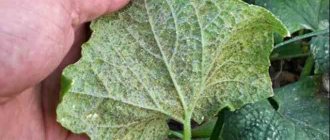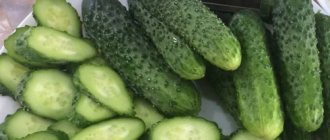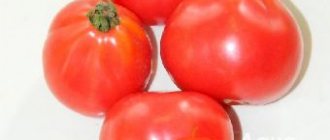The Alex f1 cucumber variety was developed by the Dutch company Bejo Zaden BV. Since 2009, there has been a subsidiary of Bejo Semena Rostov LLC in Russia. In 2007, the “Alex f1” variety was included in the State Register of Breeding Achievements approved for use. This culture has received approval from leading experts in the field of horticulture and horticulture. Growing the Alex f1 variety is permissible in any region of Russia. You can see the harvest obtained when growing in open or closed ground in the photo.
Description of Alex F1 cucumbers
The Alex cucumber bush is branched, moderately spreading, up to 1.5 m high. The leaves are small in size and have a rich green color. The flowers are female and do not require pollination. In each axil of the leaves a bunch is formed, in which from 4 to 6 ovaries.
Hybrid greens are cylindrical in shape, slightly ribbed. The color of the fruit is rich green. Cucumbers are ready to eat when their length reaches 8-10 cm, diameter - from 3.5 to 3.9 cm, weight 70-90 g.
The fruit pulp is juicy, without bitterness. The seeds are small, no voids are observed in the greens. The taste is excellent.
Alex F1 cucumbers are suitable for consumption raw and canned.
Characteristics of the variety
The fruits of this variety are not prone to overgrowth. Alex cucumbers tolerate transportation well and retain their fresh appearance for a long time.
Productivity
The formation and ripening of fruits occurs simultaneously. Compliance with agrotechnical cultivation standards allows you to get 2.8-5.8 kg of finished products from 1 m2. Harvesting is carried out every 2-3 days.
Ripening and flowering dates
From the moment the sprouts appear until the first harvest is harvested, 38 to 42 days pass. Alex F1 cucumber bushes enter the active flowering phase 30 days after emergence. Zelentsy ripen in 10-12 days.
Resistance to diseases and pests
Hybrid Alex is immune to most diseases that affect cucumber plantings of other varieties. If infected bushes appear nearby, it is unlikely that it will be possible to avoid infection.
The most dangerous diseases for Alex F1:
- Anthracnose appears in spots. When the first signs appear, the beds should be treated with Bordeaux mixture or copper sulfate solution.
- White rot. Fungal disease appears when there is high humidity. You can recognize it by its white coating. To combat the disease, diseased leaves are removed. The cut areas are treated with powdered charcoal.
- Downy mildew covers cucumber leaves with angular spots. If treatment with Bordeaux mixture does not produce results, it is recommended to use fungicides (Radomil, Ordan).
- Powdery mildew. A white coating appears on the affected leaves. From folk remedies, you can use a solution of potassium permanganate (1.5 g per 10 liters of water). Among the chemicals, “Skor” and “Topaz” are suitable.
Harmful insects that attack cucumber beds include whiteflies, spider mites and thrips. Preventive measures (timely removal of weeds, compliance with crop rotation rules) or insecticides “Confidor”, “Fitoferm”, “Intavir” will help in the fight against them.
Harvest and storage
A special feature of cucumber as a crop is the fact that these vegetables are harvested unripe, since when ripe they are only suitable for seeds. Each gardener decides for himself when the crop in the cucumber beds is ready to be harvested.
For maximum yield, it is recommended to harvest vegetables every 2 days. It is better to do this early in the morning or late in the evening, when the cucumbers are most elastic, cutting them with a knife. The first thing you need to do is hide the harvested crop from the sun by covering it with something (not film) or storing it in a cool place.
Did you know? Cucumbers spread throughout the world from the subtropical regions of India, where they still grow wild at the foot of the Himalayas.
These vegetables do not keep fresh for a long time: already on the second day after harvesting, their taste will become worse if you leave the cucumbers at room temperature. They can be stored in the cellar or refrigerator for up to 1–1.5 weeks, but you must make sure that the packaging is not airtight, otherwise the greens will “suffocate.” The cucumber variety Alex will appeal to both beginners and experienced gardeners.
It is unpretentious to growing conditions, has good fruit taste and high yield. This is a high-quality hybrid with stable immunity to most pests and diseases that are inherent in cucumber varieties. However, all its positive properties will appear only if preventive measures are taken to provide it with healthy conditions for development and fruiting.
Advantages and disadvantages
When choosing a variety, you must be sure to familiarize yourself not only with its advantages, but also find out the existing disadvantages.
Alex F1 cucumbers have a long shelf life and can be transported over long distances
Gardeners who have already grown this variety in their beds note their positive qualities:
- 4-6 ovaries are formed in a node;
- high productivity;
- excellent taste, fruits do not have bitterness;
- greens are dense, with a characteristic aroma;
- versatility of use.
There are no deficiencies identified in the Alex F1 hybrid.
Reviews
The positive qualities stated in the description of the Alex cucumber are confirmed by numerous reviews. The Dutch hybrid is very popular among gardeners.
It is grown in different types of soil, from south to north. The seed material has high germination rate. Plants produce a high, stable yield under any growing conditions. According to reviews, the variety differs from others in its higher resistance to disease. Despite the above, even this plant can get sick.
Planting cucumbers Alex
Legumes are good predecessors for Alex cucumbers. It is not recommended to plant the hybrid where zucchini or squash grew last year. It is better to choose an area for cultivation that is not shaded. It should not be blown through by a draft wind; the culture does not like cold.
Cucumbers prefer fertile soil (loamy or sandy loam soil). To obtain a rich harvest, the pH level must be neutral.
Cucumbers of the Alex F1 variety can be cultivated by seedlings and sowing in the ground. Each method has its own advantages and disadvantages.
Important! Seed producers treat planting material with fungicides, so soaking before sowing is not recommended.
Seedling method
Growing the Alex F1 hybrid through seedlings allows you to enjoy juicy fruits 10-14 days earlier
How to grow cucumber seedlings:
- The root system of the hybrid is very delicate, so it is necessary to use separate cups for planting.
- The seeds are buried 1.5-2 cm into the soil. After planting, they are watered with warm, settled water and covered with film or glass. The air temperature in the room should not be lower than +20-22˚С.
- With the emergence of seedlings, the shelter is removed. The temperature is reduced to +16˚С.
- The first fertilizing with complex fertilizers is carried out after the emergence of seedlings.
- Water once every 5-7 days. Warm water is used for irrigation.
The operation of transplanting the Alex F1 cucumber into open ground is carried out after the appearance of 3-4 leaves. Before transshipment, seedlings should be hardened off.
Sowing in open ground
Cucumber Alex is sown in the ground after the threat of night frosts has passed. To protect the beds from the appearance of pests and diseases, it is recommended to take preventive measures.
Important! The area intended for the cultivation of cucumbers is watered with boiling water with the addition of potassium permanganate seven days before sowing the seeds into the soil. Then cover with cellophane. On the day of sowing, the film is removed.
Planting material is buried 2 cm into well-heated soil. The distance between bushes is 50-60 cm, row spacing is 70-80 cm. It is not recommended to plant more than three bushes per 1 m2.
History of selection
The parthenocarpic variety Alex F1 appeared as a result of the painstaking work of Dutch breeders. The hybrid was included in the State Register of the Russian Federation in 2007. The variety quickly gained popularity among gardeners.
Designed for cultivation in open and closed ground in different climatic zones.
Growing regions
According to the State Register, “Alex” is zoned in all regions of the Russian Federation. In the Astrakhan, Volgograd regions, Crimea and Krasnodar Territory, the hybrid is approved for cultivation in open ground. In other regions, cultivation occurs in a greenhouse or greenhouse.
Caring for cucumbers Alex
Cucumbers of the Alex variety are easy to care for. But to get a high yield, you will have to make some efforts. The culture loves watering and also responds positively to fertilizing.
Watering
Cucumbers are moisture-loving plants that require regular irrigation. It should be remembered that excessive accumulation of liquid under the bushes leads to rotting of the roots.
Watering is carried out with warm, settled water. The most suitable time is morning or evening hours. It is necessary to ensure that when irrigating, the liquid does not fall on the leaves of the plant.
During dry periods, watering cucumbers is carried out every two days.
The best way to water the bushes is drip irrigation.
Loosening, weeding, mulching
Loosening of the soil is carried out after watering and rains. Weeding the beds is carried out as weeds appear, but the best solution would be to carry out the procedure every week.
Mulching significantly increases the yield of Alex cucumbers. The procedure is especially useful during the rooting period of seedlings after transplantation. You can cover the soil with sawdust, grass or agrofibre to retain moisture.
Feeding
Cucumber variety Alex F1 loves regular feeding:
- Nitrogen and organic fertilizers are applied after germination. They are necessary for gaining green mass.
- During the period of budding and flowering, the cucumber is fed at the root with nitrophoska. Foliar treatment is carried out by spraying the bushes with a solution of boric acid. Manganese crystals can be added to the same composition.
- During the appearance of fruits, foliar feeding is carried out with a urea solution.
If during the formation of the ovary the greens take on an irregular shape, humus must be added under the bushes.
Garter and bush formation
When grown outdoors, the hybrid Alex does not need shaping or staking. Cucumber cultivation is carried out horizontally. It is enough just to pinch the side shoots.
The Alex variety is grown in a greenhouse using trellises. When the bush forms 3-4 leaves, a loop is attached to the plant. Then the main lash is directed up the twine, twisting clockwise. After the appearance of 10 full leaves, the stem is pinched. The side shoots in the first three axils must be removed, the remaining ones are pinched above the third leaf.
Diseases and pests
When growing Alex cucumbers, it is imperative to implement timely prevention of subsequent diseases and pests:
- melon aphid
- sprout fly
- whitefly
- root-knot nematodes
- spider mites
- tobacco thrips
Of the pathogenic microflora, the pathogens of powdery mildew, peronospora, fusarium, white rot and blackleg pose a particular threat











